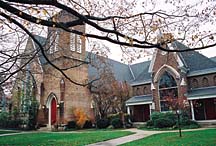
Sorg Cooling-Heating, Frankfort, was asked to submit a proposal to remove the church's existing mechanical equipment and install new HVAC equipment. The existing system consisted of hot water fancoil units (hung from the 20-foot-tall, gambrel-vaulted, wood-paneled ceiling) and wall-mounted hot water convectors.
These were to be replaced with direct-expansion fancoil units, which would be installed in the cellar/crawlspace.
The DX units would then be reconnected to the hot water boiler that had been installed in 1968, when the 10,000-square-foot education wing had been added to the church.
Church personnel suggested that there might be some flexibility in the HVAC design. Sorg took the opportunity to offer a completely different scenario.

New System Proposed
Sorg Cooling-Heating promotes high-efficiency equipment in virtually every recommendation it provides. As president Dean Sorg noted, "Our job is to educate prospects as to why the most efficient system they can own is usually going to be their best choice."Most of Sorg's work consists of renovating existing heating-cooling systems and upgrading them to more energy-efficient equipment. By dollar volume, half of the company's work is light commercial and half is residential. Virtually all of the new construction the company does is custom building.
When it came to the Church of the Ascension, Sorg didn't care for the type of system originally proposed. He envisioned a more energy-efficient design with all of the indoor air quality accoutrements. That system would consist of dual-fuel systems with Lennox 94-percent-AFUE natural gas furnaces with variable-speed blowers, and two-stage 18-SEER heat pumps.
"Our natural gas rates, after taxes and fees, exceed $20/MCF, but our electric rates are less than $0.06/kWh - some of the lowest electric rates in the nation," said Sorg. "Dual fuel would have been ideal. The rising rates for natural gas make it an important consideration for every application where folks question the comfort of heat pumps, or already have a fossil fuel system that needs replacing."

A final decision was made that encompassed most of the items in Sorg's proposal. New duct systems would be installed, along with the highest efficiency Lennox Model G32V 94-percent-AFUE, two-stage, variable-speed, natural gas furnaces. To meet the budget, the church board took the general contractor's recommendation to use standard-efficiency, single-stage, Lennox Model HS29 10-SEER, cooling-only condensing units.
The furnaces needed to be in-stalled in a 6-foot-tall cellar, which was surrounded by a 1-foot-tall crawlspace beneath the parish hall. Configuring the equipment required some engineering creativity. "Due to installation space constrictions, we found it necessary to engineer and install three separate systems for this relatively small, 2,000-square-foot parish hall," said Sorg.
The parish hall is an open space with a two-story ceiling and large stained glass windows. Sorg wound up installing two 5-ton systems, one for each side of the north and south lengths of the room, and a 4-ton system for the smaller, one-story portion of the east end of the room. Condensing units were placed on the roof of the three-story education wing.
Extruded aluminum, linear floor diffusers were placed beneath each of the large windows, and the return air duct was enclosed in unobtrusive, framed chases extending 12 feet above the floor. A horizontal grille was located in the top of each of the chases. Honeywell T8600 programmable thermostats help control space temperatures accurately.

Divine Comfort
Because the parish hall system was such a success, the church board followed another recommendation of Sorg's, which was to eliminate the water heating system and install three sets of Lennox twinned Model G26 high-efficiency, 92-percent-AFUE natural gas furnaces in the church's 10,000-square-foot education, office, and library wing. This replaced the cooling-only ducted systems (installed in 1968) and hot water wall convectors in each room.Because the duct system was already installed in this three-story building, Sorg provided two of the floors with zone damper control systems to offer better comfort and economy of operation.
The system that serves the main-floor offices, kitchen, and library system uses a RobertShaw zone damper control system, allowing the twinned, natural gas furnaces and HS29 air conditioning equipment to operate as a two-stage heating, two-stage cooling system in three zones. Each zone can be controlled and scheduled through a central display panel.
The lower level houses classrooms and the choir rehearsal room. They all have different occupancy schedules, emphasizing the zone control system's importance in the mechanical system. The third floor consists of classrooms and can be operated on the same schedule, so a single zone was sufficient there.
Sorg had to overcome some challenges in this project. Extending gas piping to each new furnace location in this historic building required important considerations for aesthetics and safety. "Providing an unobtrusive route for the 3-inch-diameter PVC exhaust and combustion air intake piping up through the historic building and out the three-story roof unobtrusively was another important task," he said.
The original parish hall project, which cost approximately $50,000, jumped another $80,000 once additional work for the offices, library, and classrooms was included. The church board recently decided to allow Sorg to act on his original proposal by replacing one of the failed 5-ton air conditioning units in the sanctuary with a Model HPXA19 18-SEER heat pump.
"We've also sealed and up-graded the sanctuary crawlspace duct system to provide unobtrusive, high-return openings and better air filtration for economy and comfort from a previously poorly operating system that is undersized," said Sorg.
The church board has asked Sorg to offer additional upgrade proposals for the sanctuary systems. That's great news for Sorg, as well as for the parishioners and clergy.
Publication date: 11/24/2003


Report Abusive Comment